15个英语最常见的介词用法-极简英语
常见的英语介词的用法总结

常见的英语介词的用法总结常见的英语介词用法表示方位的介词:in, to, on表示计量的介词:at, for, by表示材料的介词:of, from, in表示工具或手段的介词:by, with, on表示关于的介词:of, about, on表示好像或当作的介词:like, as表示除某人某物外的介词:besides, excep介词用法口诀早、午、晚要用 in,at 黎明、午夜、点与分。
年、月、年月、季节、周,阳光、灯、影、衣、帽 in。
将来时态 in ... 以后,小处 at 大处 in。
有形 with 无形 by,语言、单位、材料 in。
特征、方面与方式,心情成语惯用 in。
介词 at 和 to 表方向,攻击、位置、恶、善分。
早、午、晚要用 in介词的种类(1) 简单介词:about, across, after, against, among, around, at, before, behind, below, beside, but, by, down, during, for, from, in, of, on, over, near, round, since, to, under, up, with等等。
(2) 合成介词:inside, into, outside, throughout, upon, without, within(3) 短语介词:according to, along with, apart from, because of, in front of, in spite of, instead of, owing to, up to, with reguard to(4) 分词介词:considering, reguarding, including, concerning 介词in的常见用法1.动词+ina)动词+ inbelieve in信任, break in碎成,bring in引起;产生;带来, call in 下令收回, fill in填充,get in收获, hand in上缴, involve in涉及, lie in 在于, result in导致, share in共享,succeed in成功, take in卷起;订阅, turn in归还当局。
15个英语最常见的介词用法-极简英语

15个英语最常见介词(in on at of for...)的深层次含义英文中15个最常见的介词in/ on/at/of/ for/by /with/ from/to/as/ about/ around/ off/ through/ over一、in (在..里面)1.表示真实的位置: in the car/room2表示抽象的位置: in the book/movie3.表示状态: in danger, in trouble; in anger3.表示时间: in the morning/afternoon/evening. in April; in 20104.表示方式: in the way; in English5.表示穿着: in black shoes/T-shirt二、on (紧紧地接触-连着)1.表示真实的位置: on the table/wall2.表示抽象的位置: on the radio/TV; on the topic/event3.表示具体的时间: on Monday; on Monday morning; on May 4th4.表示状态: on duty; on holiday; the game is on三、at(在.点上)1.表示真实的位置: at home/the company/the store2.表示抽象的位置: be good/bad at English3.表示具体的时间: at 3 pm;at night; at the age of 204.表示状态: at work-在工作; at table-在吃饭四、Of(的-从属关系)1.表示"无生命主体的":the window of the room; top of the mountain...2.某某市: the city of Bejing3.表示数量: a piece/bx/bottle/pair.. of五、for(为了/因为/对时间/对.而言/支持赞成)1.表示为了":go for a walk; I come here fr my schoolbag2.表示"因为": Thank you for helping me; for the reason3.表示"时间"和: for 3 days; for a week; for a year4.表示对..而言": It is important for me5.表示”支持,赞成": Are you for this plan or against it?六、by(通过.交通工具/在.附近/街至.时间/被)1.表示"通过.交通工具":by train/subway/plane/air/ship/seaI learn English by watchingEnglish movies.2.表示在附近":a table by the window; the house is by the lake3.表示"截至到..时间":by the end of next week; by 20194.表示"被(被动语态)":English is spoken by people all over the world.七、with (伴随)1.表示"和.起":go with:play with;make friends with;cooperate with2.表示"携有,带有":a county with a long history; a house with a big garden3.表示..工具:cut the apple with the knife4.表示"伴随":with the development of the society;with the help of my teacher;I don't have any cash with me.八、from (远离)1.表示"来自":I am/come from China;a gift from my best friend;a man from America2.由"远离"来记短语:stop/prevent/keep sb from doing sth阻止某人做某事be away from...远离...be different from与.不同be absent from缺席....how far is it from here?它离这远The paper is made from wood.这纸是由木头制成的3.表示..到": from...to...由"指向"来理解下列用法:The road leads to Paris.这条路通往巴黎Smoking is harmful to your health.吸烟有害健康the answer to the question.这个问题的答案九、to (指向..)contribute to对..做贡献on one's way to... 在某人去某地的路上belong to属于..be used to doing sth习惯于做某事lead to...导致十、as作为He works as a tour guide.他作为导游工作。
介词的常见用法总结
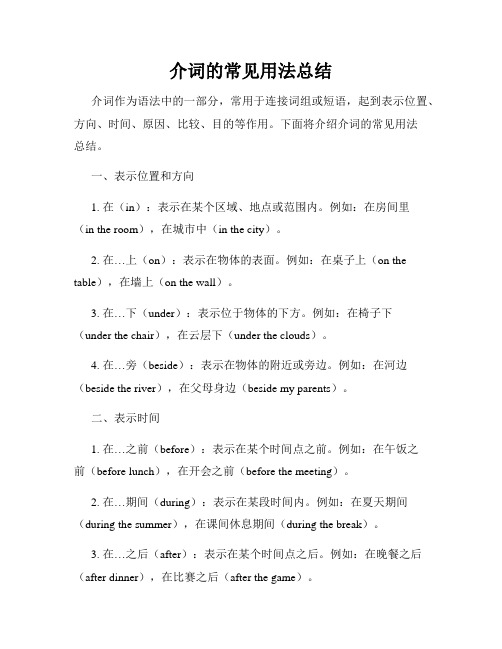
介词的常见用法总结介词作为语法中的一部分,常用于连接词组或短语,起到表示位置、方向、时间、原因、比较、目的等作用。
下面将介绍介词的常见用法总结。
一、表示位置和方向1. 在(in):表示在某个区域、地点或范围内。
例如:在房间里(in the room),在城市中(in the city)。
2. 在…上(on):表示在物体的表面。
例如:在桌子上(on the table),在墙上(on the wall)。
3. 在…下(under):表示位于物体的下方。
例如:在椅子下(under the chair),在云层下(under the clouds)。
4. 在…旁(beside):表示在物体的附近或旁边。
例如:在河边(beside the river),在父母身边(beside my parents)。
二、表示时间1. 在…之前(before):表示在某个时间点之前。
例如:在午饭之前(before lunch),在开会之前(before the meeting)。
2. 在…期间(during):表示在某段时间内。
例如:在夏天期间(during the summer),在课间休息期间(during the break)。
3. 在…之后(after):表示在某个时间点之后。
例如:在晚餐之后(after dinner),在比赛之后(after the game)。
三、表示原因1. 因为(because of):表示由于某个原因。
例如:因为天气原因(because of the weather),因为健康问题(because of health issues)。
2. 由于(due to):表示由于某种情况或原因。
例如:由于交通堵塞(due to traffic congestion),由于工作原因(due to work commitments)。
四、表示比较1. 像…一样(like):表示两个或多个事物在某些方面的相似性。
介词用法总结

介词用法总结介词是英语语法中一个重要的词类,用于表示名词、代词、动词和形容词等与其他词或短语之间的关系。
在不同的句子和语境中,介词具有不同的用法。
本文将对介词的用法进行总结,并提供相关的例句。
一、表示位置关系的介词1. in:在…之中,在(具体范围)。
例句:He is waiting in the car.(他正在车里等待。
)2. on:在…之上,在(水平面)。
例句:The book is on the table.(书在桌子上。
)3. at:在…地方,在(具体点)。
例句:She is studying at the library.(她在图书馆学习。
)4. by:在…旁边,靠近(某物)。
例句:He is standing by the door.(他站在门旁边。
)5. under:在…下面,在(某物)的底部。
例句:The cat is hiding under the bed.(猫在床下躲藏。
)6. between:在…之间(两者之间)。
例句:The restaurant is located between the bank and the supermarket.(这家餐厅位于银行和超市之间。
)二、表示时间关系的介词1. at:在(具体时间点)。
例句:She will meet her friend at 8 o'clock.(她将在8点钟见她的朋友。
)2. on:在(具体日期或星期)。
例句:I have a meeting on Monday.(星期一我有个会议。
)3. in:在(一段时间内)。
例句:He will travel to Europe in summer.(他将在夏天去欧洲旅行。
)4. during:在…期间,表示全程。
例句:I read a book during the flight.(我在飞行途中读了一本书。
)5. for:持续时间,表示时间段。
例句:They have been married for ten years.(他们已经结婚十年了。
史上超全的英语介词用法归纳总结!不看太可惜了
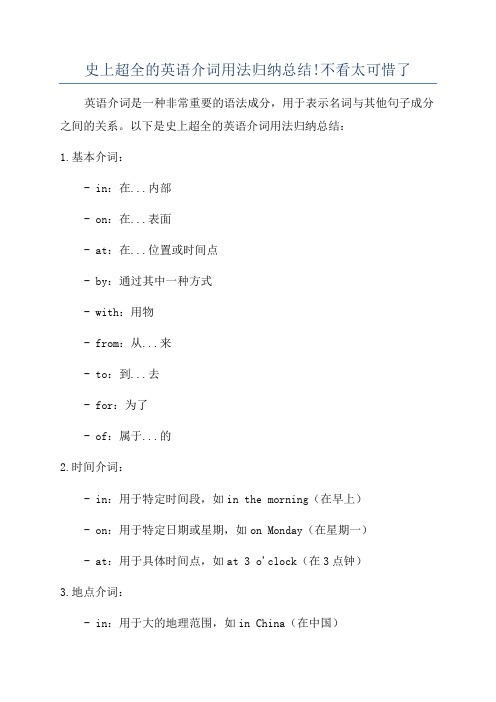
史上超全的英语介词用法归纳总结!不看太可惜了英语介词是一种非常重要的语法成分,用于表示名词与其他句子成分之间的关系。
以下是史上超全的英语介词用法归纳总结:1.基本介词:- in:在...内部- on:在...表面- at:在...位置或时间点- by:通过其中一种方式- with:用物- from:从...来- to:到...去- for:为了- of:属于...的2.时间介词:- in:用于特定时间段,如in the morning(在早上)- on:用于特定日期或星期,如on Monday(在星期一)- at:用于具体时间点,如at 3 o'clock(在3点钟)3.地点介词:- in:用于大的地理范围,如in China(在中国)- on:用于较小的地理范围或表面,如on the street(在街上)- at:用于具体地点,如at the supermarket(在超市)4.方向介词:- to:表示到达一些地方,如go to school(去学校)- into:表示进入一些地方,如go into the house(进入房子)- out of:表示离开一些地方,如get out of the car(离开车)5.原因介词:- because of:由于,如He is late because of the traffic(他因为交通堵塞而迟到)- due to:由于,如The flight was canceled due to bad weather(因为恶劣天气,航班被取消)6.动词短语介词:- look after:照顾,如She looks after her younger brother (她照顾她的弟弟)- take care of:照顾,如He takes care of his plants(他照顾他的植物)7.形容词短语介词:- interested in:对...感兴趣,如She is interested in music (她对音乐感兴趣)- good at:擅长...,如He is good at playing basketball(他擅长打篮球)8.其他常见介词用法:- with regard to:关于,如With regard to the matter, I have something to say(关于这件事,我有些话要说)- instead of:代替,如I will go instead of him(我将代替他去)- according to:根据,如According to the weather forecast, it will rain tomorrow(根据天气预报,明天会下雨)以上是一些常见的英语介词用法总结,希望能帮到你!。
40个介词用法总结

40个介词用法总结介词是英语中非常重要的一类词性,它在句子中起着连接词与词、短语与短语的作用。
介词的正确使用对于句子的表达和理解至关重要。
下面将介绍40个常见介词的用法总结,希望能够帮助大家更好地掌握介词的用法。
1. about。
介词about表示“关于”,用于询问或表达主题或内容。
例如,What are you talking about?(你在谈论什么?)。
2. above。
介词above表示“在……之上”,用于表示位置关系。
例如,The sun is above the clouds.(太阳在云层之上。
)。
3. across。
介词across表示“横过,穿过”,用于表示横跨某个区域或穿过某个物体。
例如,We walked across the bridge.(我们走过了桥。
)。
4. after。
介词after表示“在……之后”,用于表示时间先后关系。
例如,We'll go for a walk after dinner.(晚饭后我们会去散步。
)。
5. against。
介词against表示“靠着,依靠”,用于表示两个物体之间的接触或支撑关系。
例如,He leaned against the wall.(他靠在墙上。
)。
6. along。
介词along表示“沿着”,用于表示沿着某个方向或路线。
例如,We walked along the river.(我们沿着河边走。
)。
7. amid。
介词amid表示“在……之中”,用于表示某个场所或环境中。
例如,The children played happily amid the flowers.(孩子们在花丛中快乐地玩耍。
)。
8. among。
介词among表示“在……之中”,用于表示三个或三个以上的人或物之间的关系。
例如,She is among the top students in her class.(她是班里的尖子学生之一。
)。
9. around。
英语介词的用法归纳
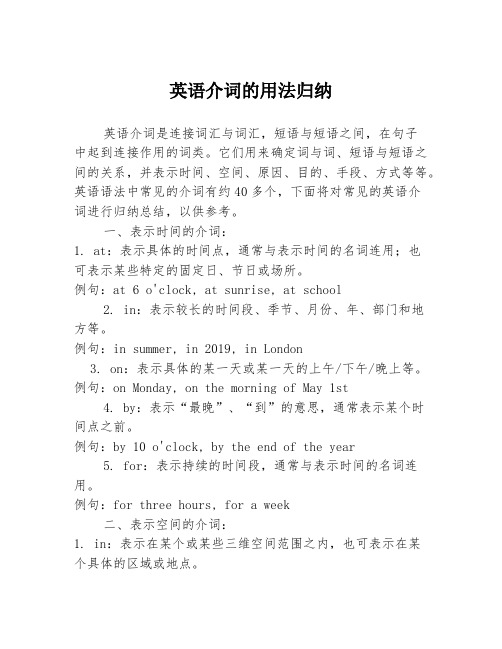
英语介词的用法归纳英语介词是连接词汇与词汇,短语与短语之间,在句子中起到连接作用的词类。
它们用来确定词与词、短语与短语之间的关系,并表示时间、空间、原因、目的、手段、方式等等。
英语语法中常见的介词有约40多个,下面将对常见的英语介词进行归纳总结,以供参考。
一、表示时间的介词:1. at:表示具体的时间点,通常与表示时间的名词连用;也可表示某些特定的固定日、节日或场所。
例句:at 6 o'clock, at sunrise, at school2. in:表示较长的时间段、季节、月份、年、部门和地方等。
例句:in summer, in 2019, in London3. on:表示具体的某一天或某一天的上午/下午/晚上等。
例句:on Monday, on the morning of May 1st4. by:表示“最晚”、“到”的意思,通常表示某个时间点之前。
例句:by 10 o'clock, by the end of the year5. for:表示持续的时间段,通常与表示时间的名词连用。
例句:for three hours, for a week二、表示空间的介词:1. in:表示在某个或某些三维空间范围之内,也可表示在某个具体的区域或地点。
例句:in the room, in the park2. on:表示在某个平面面上,通常用来表示地点。
例句:on the table, on the wall3. at:表示在某个具体的地点或位置。
例句:at the door, at the bus stop4. by:表示“靠近”、“经过”等含义。
例句:by the river, by the window5. between:表示在两个或两个以上的物体或位置之间。
例句:between two mountains, between the buildings6. among:表示在三个或三个以上的物体或位置之间。
介词的用法总结

介词的用法1.表示地点位置的介词1)at ,in, on, to,forat (1)表示在小地方; (2)表示“在……附近,旁边”in (1)表示在大地方; (2)表示“在…范围之内”。
on 表示毗邻,接壤,“在……上面”。
to 表示在……范围外,不强调是否接壤;或“到……”2)above, over, on 在……上above 指在……上方,不强调是否垂直,及 below相对;over指垂直的上方,及under相对,但over及物体有一定的空间,不直接接触。
on表示某物体上面并及之接触。
The bird is flying above my head. There is a bridge over the river. He put his watch on the desk.3)below, under 在……下面under表示在…正下方below表示在……下,不一定在正下方There is a cat under the table.Please write your name below the line.4)in front [frant]of, in the front of在……前面in front of…意思是“在……前面”,指甲物在乙物之前,两者互不包括;其反义词是behind(在……的后面)。
There are some flowers in front of the house.(房子前面有些花卉。
) in the front of 意思是“在…..的前部”,即甲物在乙物的内部.反义词是at the back of…(在……范围内的后部)。
There is a blackboard in the front of our classroom.我们的教室前边有一块黑板。
Our teacher stands in the front of the classroom.我们的老师站在教室前.(老师在教室里)5)beside,behindbeside 表示在……旁边behind 表示在……后面2.表示时间的介词1)in , on,at 在……时in表示较长时间,如世纪、朝代、时代、年、季节、月及一般(非特指)的早、中、晚等。
史上超全的英语介词用法归纳总结!不看太可惜了
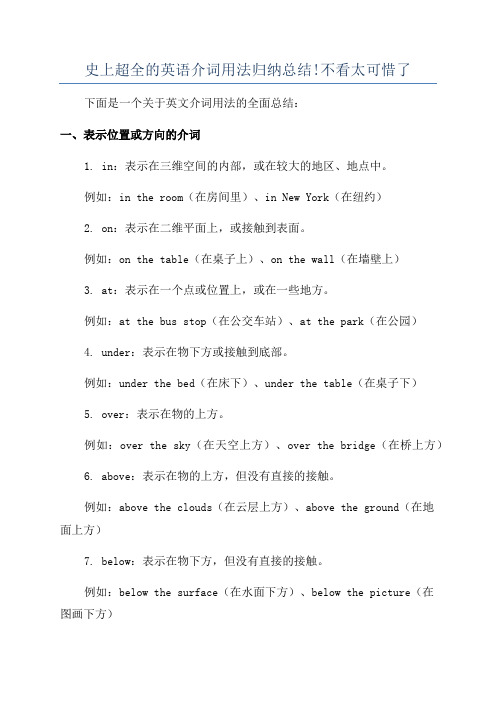
史上超全的英语介词用法归纳总结!不看太可惜了下面是一个关于英文介词用法的全面总结:一、表示位置或方向的介词1. in:表示在三维空间的内部,或在较大的地区、地点中。
例如:in the room(在房间里)、in New York(在纽约)2. on:表示在二维平面上,或接触到表面。
例如:on the table(在桌子上)、on the wall(在墙壁上)3. at:表示在一个点或位置上,或在一些地方。
例如:at the bus stop(在公交车站)、at the park(在公园)4. under:表示在物下方或接触到底部。
例如:under the bed(在床下)、under the table(在桌子下)5. over:表示在物的上方。
例如:over the sky(在天空上方)、over the bridge(在桥上方)6. above:表示在物的上方,但没有直接的接触。
例如:above the clouds(在云层上方)、above the ground(在地面上方)7. below:表示在物下方,但没有直接的接触。
例如:below the surface(在水面下方)、below the picture(在图画下方)8. beside:表示在物的旁边。
例如:beside the lake(在湖边)、beside the tree(在树旁)9. between:表示在两个物体或位置之间。
例如:between the two buildings(在两座建筑物之间)、between the chair and the table(在椅子和桌子之间)10. among:表示在三个或更多的物体之间。
例如:among the flowers(在花朵之间)、among the students (在学生之间)二、表示时间的介词1. at:表示一个点的特定时间。
例如:at 9 o'clock(在9点)2. on:表示在其中一天或日期。
40个介词用法总结

40个介词用法总结介词是连接词类别中的一种,用来连接名词、代词、动词或动词词组并起到限定或修饰的作用,能够描绘出事物之间的空间、方向、时间、原因、目的、手段、方式、比较、伴随等关系。
介词在英语中有很多种,下面将总结40个常见的介词及其用法:1. about(关于):用于描述一个主题或问题。
例如:We had a discussion about the project.2. above(在……上面):用于描述物体的位置。
例如:The moon is above the clouds.3. across(横穿):表示从一边到另一边。
例如:We walked across the bridge.4. after(在……之后):表示在某个事件或时间之后。
例如:He went to the park after school.5. against(对抗):表示在某个物体或力量之间的对抗。
例如:They were playing against each other in the soccer game.6. along(沿着):表示沿着某个路径或边缘。
例如:We walked along the beach.7. among(在……之中):表示在同一群体中或在一些物体之间。
例如:They shared the prize among themselves.8. around(在……周围):表示围绕某个物体或区域。
例如:She ran around the track.9. before(在……之前):表示在某个事件或时间之前。
例如:Please finish your homework before dinner.10. behind(在……后面):表示在某个物体或地点的后面。
例如:He hid behind the tree.11. below(在……下面):表示在某个物体或地点的下面。
例如:The book is below the desk.12. beneath(在……下方):表示在某个物体的下方。
英语语法丨介词用法大全,简单又实用
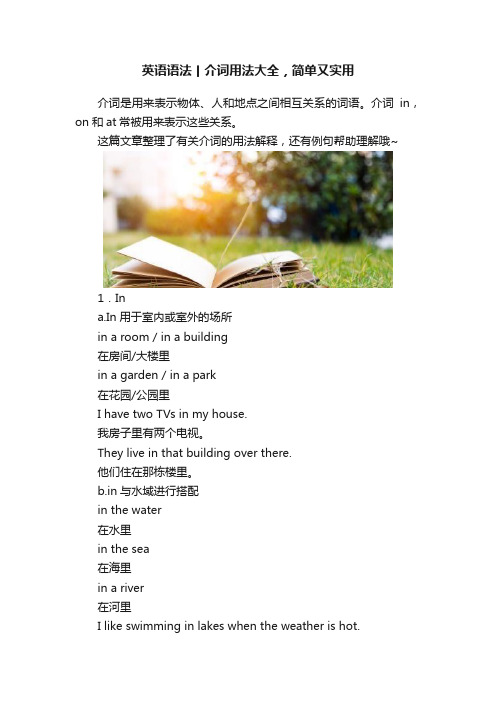
英语语法丨介词用法大全,简单又实用介词是用来表示物体、人和地点之间相互关系的词语。
介词in,on和at常被用来表示这些关系。
这篇文章整理了有关介词的用法解释,还有例句帮助理解哦~1.Ina.In用于室内或室外的场所in a room / in a building在房间/大楼里in a garden / in a park在花园/公园里I have two TVs in my house.我房子里有两个电视。
They live in that building over there.他们住在那栋楼里。
b.in与水域进行搭配in the water在水里in the sea在海里in a river在河里I like swimming in lakes when the weather is hot.我喜欢天气热时在湖里游泳。
You can catch fish in the river.你可以在湖里捉鱼。
c.in和行、队伍等进行搭配in a row / in a line一行in a queue一队Let's stand in line and get a ticket to the concert.站成一行,买票去听音乐会。
We had to wait in a queue to get into the bank.我们只得站成一队等着进入公园。
d. in与城市、县、州、地区和国家搭配Peter lives in Chicago.皮特住在芝加哥。
Helen is in France this month. Next month she'll be in Germany.海伦这个月在法国。
下个月她就在德国了。
2.Ata.at与具体的地点进行搭配at the bus-stop在公交车站at the door在门边at the cinema在电影院at the end of the street在街的尽头I'll meet you at the movie theater at six o'clock. 我六点在电影院见你。
介词英语词汇大全掌握使用场景提高语言准确性
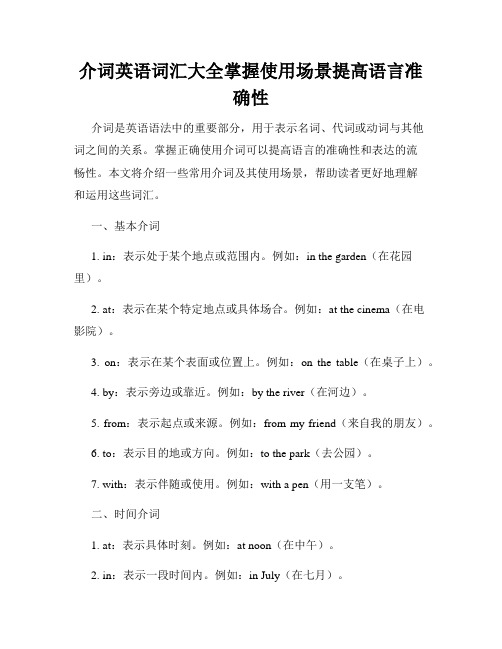
介词英语词汇大全掌握使用场景提高语言准确性介词是英语语法中的重要部分,用于表示名词、代词或动词与其他词之间的关系。
掌握正确使用介词可以提高语言的准确性和表达的流畅性。
本文将介绍一些常用介词及其使用场景,帮助读者更好地理解和运用这些词汇。
一、基本介词1. in:表示处于某个地点或范围内。
例如:in the garden(在花园里)。
2. at:表示在某个特定地点或具体场合。
例如:at the cinema(在电影院)。
3. on:表示在某个表面或位置上。
例如:on the table(在桌子上)。
4. by:表示旁边或靠近。
例如:by the river(在河边)。
5. from:表示起点或来源。
例如:from my friend(来自我的朋友)。
6. to:表示目的地或方向。
例如:to the park(去公园)。
7. with:表示伴随或使用。
例如:with a pen(用一支笔)。
二、时间介词1. at:表示具体时刻。
例如:at noon(在中午)。
2. in:表示一段时间内。
例如:in July(在七月)。
3. on:表示某一天或日期。
例如:on Sunday(在星期日)。
4. during:表示在某个时间段内。
例如:during the summer(在夏季期间)。
5. for:表示一段时间。
例如:for two hours(两个小时)。
三、方式和原因介词1. with:表示使用某种工具或方式。
例如:with a hammer(用锤子)。
2. by:表示通过某种方式或交通工具。
例如:by bike(骑自行车)。
3. because of:表示原因或理由。
例如:because of the rain(因为下雨)。
四、目的和结果介词1. for:表示目的或意图。
例如:for breakfast(为了早餐)。
2. to:表示趋向或目标。
例如:to the library(到图书馆)。
3. so that:表示结果或目的。
介词用法归纳与总结

介词用法归纳与总结介词是英语中非常重要的一部分,它用于连接名词或代词与其他句子成分,表达位置、时间、原因、方式等概念。
正确使用介词能够准确表达自己的意思,加强句子的连贯性和表达的精确度。
本文将对常见的介词及其用法进行归纳与总结。
1. 位置关系介词用于表示物体或人的位置关系,常见的介词有:in、on、at、under、over等。
- in:表示在某个区域或范围内。
例如:in the park(在公园里)、in the house(在房子里)。
- on:表示在某个表面或位置上。
例如:on the table(在桌子上)、on the beach(在海滩上)。
- at:表示在某个具体位置。
例如:at the bus stop(在公车站)、at school(在学校)。
- under:表示在某物之下。
例如:under the tree(在树下)、under the bed(在床下)。
- over:表示在某物之上。
例如:over the bridge(在桥上)、over the clouds(在云上)。
2. 时间关系介词用于表示时间关系,常见的介词有:at、on、in、before、after、during等。
- at:表示具体时间点。
例如:at 7 o'clock(在7点)、at midnight (在午夜)。
- on:表示某个具体的日期或星期几。
例如:on Monday(在星期一)、on Christmas Day(在圣诞节)。
- in:表示一个时间段或月份。
例如:in the morning(在早上)、in July(在七月)。
- before:表示在某个时间之前。
例如:before sunset(在日落之前)、before the meeting(在会议之前)。
- after:表示在某个时间之后。
例如:after breakfast(在早餐之后)、after the show(在演出之后)。
介词常见11个用法归纳

介词常见11个用法归纳介词是连接词语与其他词语或词组的一种词类。
以下是介词的常见用法归纳:1. 表示地点:at, in, on例如:at school(在学校)、in the park(在公园)、on the table(在桌子上)2. 表示方向:to例如:go to the library(去图书馆)3. 表示时间:at, in, on例如:at 9 o'clock(在9点)、in July(在七月)、on Monday(在星期一)4. 表示原因:because of, due to例如:He failed the test because of his laziness(他因为懒惰而考试不及格)5. 表示目的:for例如:I bought some flowers for my mother(我买了些花给我妈妈)6. 表示手段或方式:by, with例如:She traveled to Paris by plane(她乘飞机去巴黎)7. 表示比较:than例如:He is taller than his sister(他比他姐姐高)8. 表示身份或性质:as例如:He works as a doctor(他是个医生)9. 表示关系:of例如:a book of poems(一个诗集)10. 表示来源:from例如:I received a gift from my friend(我收到了一份来自朋友的礼物)11. 表示递进或对比:besides, but, except, apart from例如:She likes all kinds of food, besides seafood(她喜欢各种食物,除了海鲜)。
英语介词用法最全总结
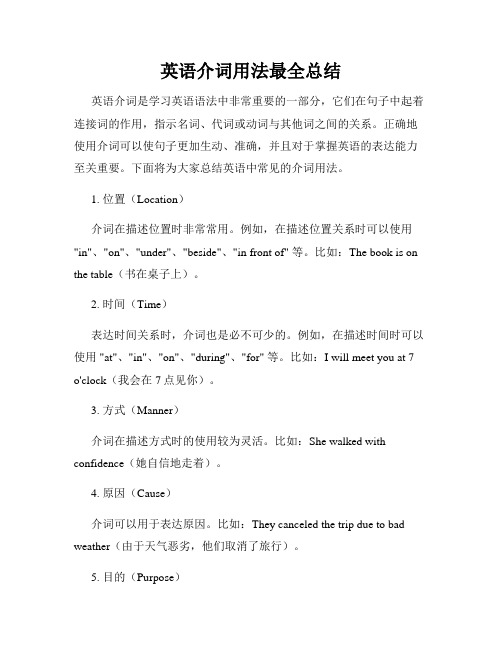
英语介词用法最全总结英语介词是学习英语语法中非常重要的一部分,它们在句子中起着连接词的作用,指示名词、代词或动词与其他词之间的关系。
正确地使用介词可以使句子更加生动、准确,并且对于掌握英语的表达能力至关重要。
下面将为大家总结英语中常见的介词用法。
1. 位置(Location)介词在描述位置时非常常用。
例如,在描述位置关系时可以使用"in"、"on"、"under"、"beside"、"in front of" 等。
比如:The book is on the table(书在桌子上)。
2. 时间(Time)表达时间关系时,介词也是必不可少的。
例如,在描述时间时可以使用 "at"、"in"、"on"、"during"、"for" 等。
比如:I will meet you at 7 o'clock(我会在7点见你)。
3. 方式(Manner)介词在描述方式时的使用较为灵活。
比如:She walked with confidence(她自信地走着)。
4. 原因(Cause)介词可以用于表达原因。
比如:They canceled the trip due to bad weather(由于天气恶劣,他们取消了旅行)。
5. 目的(Purpose)介词也能表达目的。
比如:He went to the store to buy some groceries (他去商店买些食品)。
6. 所属关系(Possession)介词可以用于表达所属关系。
比如:This book belongs to me(这本书是我的)。
7. 比较(Comparison)在进行比较时,介词也可以派上用场。
比如:I am taller than my sister(我比我妹妹高)。
英语介词的用法归纳
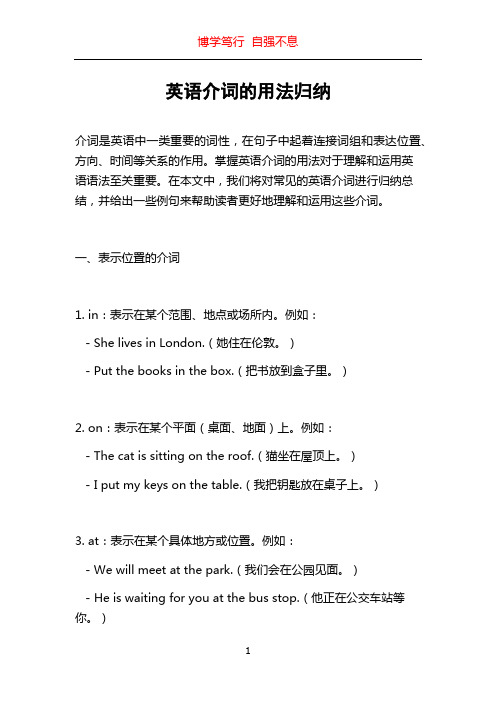
英语介词的用法归纳介词是英语中一类重要的词性,在句子中起着连接词组和表达位置、方向、时间等关系的作用。
掌握英语介词的用法对于理解和运用英语语法至关重要。
在本文中,我们将对常见的英语介词进行归纳总结,并给出一些例句来帮助读者更好地理解和运用这些介词。
一、表示位置的介词1. in:表示在某个范围、地点或场所内。
例如:- She lives in London.(她住在伦敦。
)- Put the books in the box.(把书放到盒子里。
)2. on:表示在某个平面(桌面、地面)上。
例如:- The cat is sitting on the roof.(猫坐在屋顶上。
)- I put my keys on the table.(我把钥匙放在桌子上。
)3. at:表示在某个具体地方或位置。
例如:- We will meet at the park.(我们会在公园见面。
)- He is waiting for you at the bus stop.(他正在公交车站等你。
)二、表示方向的介词1. to:表示动作的方向。
例如:- I went to the supermarket.(我去了超市。
)- She walked to the park.(她走到了公园。
)2. into:表示进入某个地方或物体内部。
例如:- The cat jumped into the box.(猫跳进了盒子里。
)- He put the book into his bag.(他把书放进了书包里。
)3. out of:表示离开某个地方或物体外部。
例如:- She ran out of the room.(她从房间里跑了出来。
)- Take the dishes out of the dishwasher.(把盘子从洗碗机里取出来。
)三、表示时间的介词1. at:表示具体的时间点。
例如:- The party starts at 7 p.m.(晚会从晚上7点开始。
常用介词用法总结
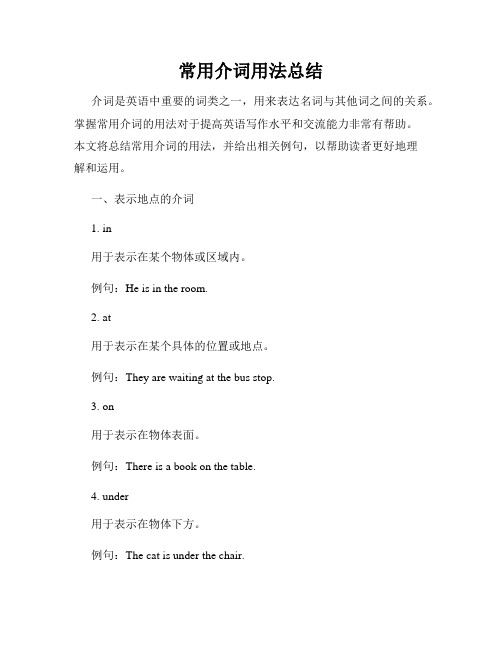
常用介词用法总结介词是英语中重要的词类之一,用来表达名词与其他词之间的关系。
掌握常用介词的用法对于提高英语写作水平和交流能力非常有帮助。
本文将总结常用介词的用法,并给出相关例句,以帮助读者更好地理解和运用。
一、表示地点的介词1. in用于表示在某个物体或区域内。
例句:He is in the room.2. at用于表示在某个具体的位置或地点。
例句:They are waiting at the bus stop.3. on用于表示在物体表面。
例句:There is a book on the table.4. under用于表示在物体下方。
例句:The cat is under the chair.5. above用于表示在物体上方。
例句:The bird is flying above the tree.6. below用于表示在物体下方。
例句:The fish is swimming below the water surface.二、表示时间的介词1. at用于表示具体的时间点。
例句:We have a meeting at 9 o'clock.2. on用于表示具体的日期或星期几。
例句:We usually have a party on Christmas Day. 3. in用于表示月份、年份或季节等较长的时间段。
例句:She was born in 1990.4. during用于表示在某一时间段内。
例句:We went skiing during the winter vacation.三、表示原因的介词1. because of用于表示因为某个原因。
例句:He couldn't come because of the heavy rain.2. due to用于表示由于某个原因。
例句:The cancellation of the flight was due to the bad weather.四、表示方式的介词1. by用于表示通过某种方式或方法。
介词的常见用法

介词的常见用法介词是一个常见的词类,用于在句子中连接名词、代词、动词或其他词类,表示它们之间的关系。
介词的使用非常灵活多样,本文将重点介绍介词的常见用法,并提供一些例句来帮助读者更好地理解。
一、表示位置关系的介词1. in:表示在某个范围或物体内部。
例如:She is reading a book in the library.她正在图书馆读书。
2. on:表示在某个表面或物体的上方。
例如:The book is on the table.书在桌子上。
3. at:表示在某个地点或事件发生的地方。
例如:We will meet at the park tomorrow.我们明天在公园见面。
二、表示时间关系的介词1. at:表示具体的时刻或某个时间点。
例如:She will arrive at 8 o'clock.她将在8点钟到达。
2. on:表示具体的某一天或某个特定的日期。
例如:We have a meeting on Monday.我们星期一有个会议。
3. in:表示在某个时间段或某个月、季节、年份。
例如:He was born in 1990.他出生在1990年。
三、表示原因、目的、方式的介词1. for:表示目的或原因。
例如:She bought a gift for her friend.她给她的朋友买了一份礼物。
2. to:表示目的或方向。
例如:We went to the park to have a picnic.我们去公园野餐。
3. by:表示方式或方法。
例如:He goes to work by bike.他骑自行车上班。
四、表示从属关系、比较关系的介词1. of:表示从属关系或所属关系。
例如:The color of the car is red.这辆车的颜色是红色。
2. from:表示来源或出处。
例如:I received a letter from my friend.我收到了一封来自朋友的信。
英语中所有介词的用法
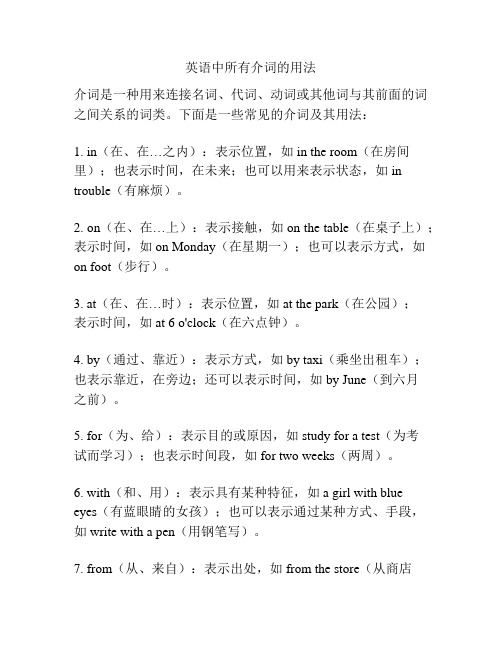
英语中所有介词的用法
介词是一种用来连接名词、代词、动词或其他词与其前面的词之间关系的词类。
下面是一些常见的介词及其用法:
1. in(在、在…之内):表示位置,如in the room(在房间里);也表示时间,在未来;也可以用来表示状态,如in trouble(有麻烦)。
2. on(在、在…上):表示接触,如on the table(在桌子上);表示时间,如on Monday(在星期一);也可以表示方式,如on foot(步行)。
3. at(在、在…时):表示位置,如at the park(在公园);
表示时间,如at 6 o'clock(在六点钟)。
4. by(通过、靠近):表示方式,如by taxi(乘坐出租车);也表示靠近,在旁边;还可以表示时间,如by June(到六月
之前)。
5. for(为、给):表示目的或原因,如study for a test(为考
试而学习);也表示时间段,如for two weeks(两周)。
6. with(和、用):表示具有某种特征,如a girl with blue
eyes(有蓝眼睛的女孩);也可以表示通过某种方式、手段,
如write with a pen(用钢笔写)。
7. from(从、来自):表示出处,如from the store(从商店
里);表示起点,如from London(从伦敦)。
8. to(到、向):表示目的地,如go to school(去学校);表示方向,如face to the north(面朝北方)。
这只是一部分介词的使用方法,介词的用法还有很多,需要根据具体语境来理解和运用。
- 1、下载文档前请自行甄别文档内容的完整性,平台不提供额外的编辑、内容补充、找答案等附加服务。
- 2、"仅部分预览"的文档,不可在线预览部分如存在完整性等问题,可反馈申请退款(可完整预览的文档不适用该条件!)。
- 3、如文档侵犯您的权益,请联系客服反馈,我们会尽快为您处理(人工客服工作时间:9:00-18:30)。
15个英语最常见介词(in on at of for...)的深层次含义英文中15个最常见的介词
in/ on/at/of/ for/by /with/ from/to/as/ about/ around/ off/ through/ over
一、in (在..里面)
1.表示真实的位置: in the car/room
2表示抽象的位置: in the book/movie
3.表示状态: in danger, in trouble; in anger
3.表示时间: in the morning/afternoon/evening. in April; in 2010
4.表示方式: in the way; in English
5.表示穿着: in black shoes/T-shirt
二、on (紧紧地接触-连着)
1.表示真实的位置: on the table/wall
2.表示抽象的位置: on the radio/TV; on the topic/event
3.表示具体的时间: on Monday; on Monday morning; on May 4th
4.表示状态: on duty; on holiday; the game is on
三、at(在.点上)
1.表示真实的位置: at home/the company/the store
2.表示抽象的位置: be good/bad at English
3.表示具体的时间: at 3 pm;at night; at the age of 20
4.表示状态: at work-在工作; at table-在吃饭
四、Of(的-从属关系)
1.表示"无生命主体的":
the window of the room; top of the mountain...
2.某某市: the city of Bejing
3.表示数量: a piece/bx/bottle/pair.. of
五、for(为了/因为/对时间/对.而言/支持赞成)
1.表示为了":
go for a walk; I come here fr my schoolbag
2.表示"因为": Thank you for helping me; for the reason
3.表示"时间"和: for 3 days; for a week; for a year
4.表示对..而言": It is important for me
5.表示”支持,赞成": Are you for this plan or against it?
六、by(通过.交通工具/在.附近/街至.时间/被)
1.表示"通过.交通工具":
by train/subway/plane/air/ship/sea
I learn English by watching
English movies.
2.表示在附近":
a table by the window; the house is by the lake
3.表示"截至到..时间":
by the end of next week; by 2019
4.表示"被(被动语态)":
English is spoken by people all over the world.
七、with (伴随)
1.表示"和.起":
go with:play with;make friends with;cooperate with
2.表示"携有,带有":
a county with a long history; a house with a big garden
3.表示..工具:
cut the apple with the knife
4.表示"伴随":
with the development of the society;
with the help of my teacher;
I don't have any cash with me.
八、from (远离)
1.表示"来自":
I am/come from China;
a gift from my best friend;
a man from America
2.由"远离"来记短语:
stop/prevent/keep sb from doing sth阻止某人做某事be away from...远离...
be different from与.不同
be absent from缺席....
how far is it from here?它离这远
The paper is made from wood.这纸是由木头制成的3.表示..到": from...to...
由"指向"来理解下列用法:
The road leads to Paris.这条路通往巴黎
Smoking is harmful to your health.吸烟有害健康
the answer to the question.这个问题的答案
九、to (指向..)
contribute to对..做贡献
on one's way to... 在某人去某地的路上
belong to属于..
be used to doing sth习惯于做某事
lead to...导致
十、as作为
He works as a tour guide.
他作为导游工作。
As a teacher, you should be responsible for your students. 作为老师你应该对你的学生负责。
十一、about (在..附近=around)
1. something about your country.
关于你国家的一-些事
2. the movie is about education.
这部电影是关于教育的。
3.I get up at about7am.
我大约上午七点钟起床。
4. The road is about 100 meters long.
这条路大约100米长。
5. think/talk/worry about..
be angry/excited/upset about
6. He is walking about the city.
他在城里转悠。
十二、off (脱离,分开)
1. take off脱掉衣服;起飞
Take off your coat; The plane is taking off.
2. fall off从.掉落
The apple fell off the tree.
3. get off the car.下车
4. turn off the TV/light/gas
关掉电视灯/煤气
5. set off出发
They set off very early in the morning.
十三、through (内部穿过去)
1. Go though the forest 穿过森林
2. A river goes through the city.
一条小河穿过这座城市
3. He became rich through hard work
他通过辛劳的工作变得富有
4. He got the job through his uncle.
他通过他叔叔找到了工作
5. We worked through the night.
我们通宵工作
十四、over (在上面,跨过去)
1. We are over.我们结束了;
Game over.游戏结束。
2. go over复习
You should go over what you learn before you take an exam.
3. come over顺便来访
Your uncle came over yesterday.
4. turn over翻转
If you turn over a turtle on its back, it becomes helpless.
如果你把乌龟翻过来,使它的肚皮向上,它就没有办法了。
